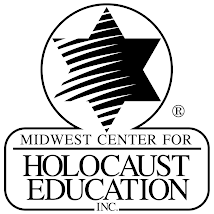This is a guest blog by Terry Beasley, an educator at Lakeview Middle School in the Park Hill School District. This summer Terry was MCHE's representative to the Alfred Lerner Summer Institute for Teachers held by the Jewish Foundation for the Righteous.
__________________________________________________________________________________
I headed to New York on June 25, 2011 to participate in the Alfred Lerner Fellow Summer Institute for Teachers. I was one of 35 educators selected for this prestigious program held on the campus of Columbia University. I was looking forward to gaining new knowledge and instructional strategies that I could use in my classroom during our studies of the Holocaust. I had completed my assigned readings, completed my pre-institute assignments, and had my suitcase packed.
My experience with the Alfred Lerner Fellowship Institute was more than I could have imagined. The caliber of instructors and presenters during the week was exceptional. I was very fortunate to have this opportunity.
Professor John Roth gave a historical history of the evolution of anti-Semitism based on the religious differences throughout history. Professor Volker Berghahn discussed the interwar period in Germany and the impact of World War I on all the nations, which helped clarify the mindset of the various nations. Professor Harry Reicher, University of Pennsylvania Law School, gave an amazing and very insightful presentation on how Hitler and the Nazi regime used the law to manipulate Germany and its citizens. I found this session extremely interesting because it clarified how the Nazi Party was able to use the legal system as a tool or vehicle to obtain the goals of the Nazi organization. Professor Peter Hayes discussed the use of big business by the Nazi government and really explained how businesses became involved and then immersed in the crimes of the Nazis. Henry Feingold addressed the issue of refugees and the responses of individuals and countries to this world crisis. Professor Jeffrey Burds did an excellent presentation on the use of propaganda by the Nazi regime. Much of the information that Professor Burds shared was new documentation that he has been researching in recent years. This new evidence shows how the Nazis targeted propaganda for different regions of Europe to personalize anti-Semitism in specific areas.
Sheila Hanson from the Shoah Foundation instructed us on how to access IWitness to access the visual history testimonies of over 52,000 individuals from 56 countries. These resources can be used in a variety of ways by teachers or by students. Roman Kent shared his personal story of his life and survival before, during and after the Holocaust. He stressed that any study of the Holocaust should include who the people were before and who they were afterwards. Mr. Kent was so personable and his story was quite emotional. The author and instructor Nechama Tec shared her personal testimony and then led a question and answer session regarding her books she started writing in 1970 when her memories started becoming an issue for her.
Our final day was spent with Robert Jan van Pelt, who traveled to Germany in the fall of 1989 following the fall of the Berlin Wall to search the archives of Nazi Germany. Professor van Pelt told many fascinating accounts of his experiences with Holocaust research and documentation.
Another aspect of this experience was the connections and friendships that evolved. I met many passionate and dedicated educators from all parts of the United States who are dedicated to teaching the truth about this historical event. I had the pleasure of sharing my room with Katarzyna from Minsk, Poland. We had four educators from Poland, one journalist who works at Auschwitz, one employee from the United Nations, and two educators from Croatia in our fellowship. The opportunity to discuss and collaborate with educators from these areas was so insightful and meaningful as we shared teaching strategies, as well as historical perspectives. It was a wonderful group of individuals with whom I will continue to communicate with in the future.
On a personal note, my selection as the recipient of the Eduard Sonder Award was extremely impacting for me. Based on my application, the granddaughters of Mr. Sonder select the recipient of this annual award. I met both of the granddaughters, as well as a great-granddaughter and a great-great granddaughter while I was attending the ALF Institute in New York. I had an opportunity to visit with all of them following a presentation. I was given a copy of the family story, a copy of a family photograph of Eduard Sonder, and a box of chocolates from the same Swiss Chocolatier that Mr. Sonder would bring to his granddaughters from his business travels when the family lived in Germany. Both of the granddaughters are such delightful ladies and I was so humbled that they selected me.
I am thankful for the opportunity to have been an Alfred Lerner Fellow and to those who encouraged me to apply, as well as to those who helped support my journey. I believe that I am better equipped as a teacher to help my students understand the depth and the impact of the Holocaust.


